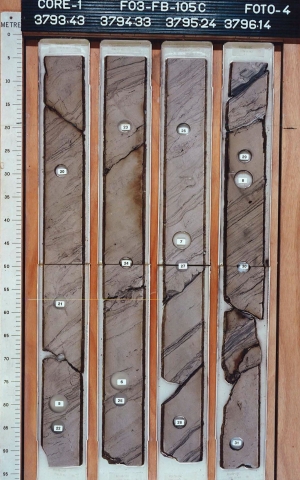Code
SLCMS
Status
Formal (Herngreen & Wong 1989). Amended (Van Adrichem Boogaert & Kouwe 1993).
Lithological description
Yellow fine-medium, moderately sorted sandstone with calcareous cement. The sands are often characterised by one or two coal beds, showing a spiky character on the GR-log. The sandy bodies have a distinct coarsening upward trend. In a few areas a double sand body is present, both parts with a coarsening upward trend.
Depositional setting
Prograding lake delta fill complexes.
Definition of lower boundary
Characterised by distinct (Gamma Ray, interval transit time & Resistivity) log breaks defining the contact with the underlying non-calcareous claystones of the Middle Graben Formation.
Definition of upper boundary
Characterised by distinct (Gamma Ray, Int. transit time & Resistivity) log breaks defining the contact with the overlying non-calcareous claystones of the Middle Graben Formation.
Thickness indication
Up to 52 m.
Geographical distribution
Regional correlation
UK: Humber Group; GER: ?; BEL: -.
Age
early Oxfordian - middle Oxfordian.
Holostratotype
Well:
Depth (thickness) AH:
2628 - 2648 m (20 m)
Origin of name
Named after the Central Graben.
Previous name(s)
None.
Reviewed by (date)
Sander Houben (2017).
References
Herngreen, G.F.W. and Wong, Th.E. 1989. Revision of the ’Late Jurassic’ stratigraphy of the Dutch Central North Sea Graben - Geol. en Mijnbouw, 68, p. 73-105.
Van Adrichem Boogaert, H.A. & Kouwe, W.F.P. 1993. Stratigraphic nomenclature of The Netherlands; revision and update by RGD and NOGEPA, Section G, Upper Jurassic and Lower Cretaceous. Mededelingen Rijks Geologische Dienst, 50, 1-80..
Cite as
TNO-GDN ([YEAR]). Middle Graben Sandstone Member. In: Stratigraphic Nomenclature of the Netherlands, TNO – Geological Survey of the Netherlands. Accessed on [DATE] from http://acc.dinoloket.nl/en/stratigraphic-nomenclature/middle-graben-sandstone-member.
